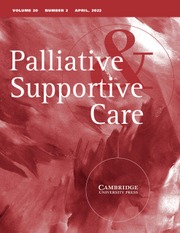In the corridors of a major oncologic hospital, where precision and technology shape daily decisions, one deceptively simple question continues to echo: “How much time do I have?” No image, biomarker, or score provides a definitive answer. Even the most experienced clinician hesitates – not from lack of knowledge, but from recognition of the profound uncertainty that defines the end of life.
Prognostication in palliative care unfolds between measurable parameters and human presence. Clinical tools offer structure and orientation, but they are insufficient. Some patients who seem close to death live unexpectedly long. Others with favorable indicators decline rapidly. Life, like suffering, resists being fully captured by metrics. As Cassell wrote, suffering is not only physical – it is deeply personal, relational, and moral (Cassel Reference Cassel1982). Prognosis cannot be reduced to probability.
Every estimate of survival is a kind of narrative. To suggest that someone has “days to weeks” is not a neutral transmission of data. It opens space for choices, preparation, and meaning. Prognostic tools, when used without narrative awareness, risk becoming instruments of reduction. They must be used as guides, not verdicts.
Uncertainty is not a failure of medicine. It is the very terrain where the most important work of care occurs. Clinical encounters near the end of life require more than prediction. They demand attunement – to emotional reserves, unspoken bonds, and subtle shifts that no algorithm detects.
Recent qualitative studies describe this experience as a “state of transience” – a reorganization of time, identity, and orientation to the future caused by serious illness (Belar et al. Reference Belar, Arantzamendi and Larkin2024). In these moments, standard language and prognostic boundaries often fail to express what patients and families feel. Clinical presence becomes a way of dwelling within this suspended time.
Some screening approaches embrace this uncertainty directly. The “surprise question” – “Would you be surprised if this patient died within the next year?” – has gained prominence not for its predictive precision but for what it enables: earlier conversations, deeper support, and timely planning. The NECPAL and SPICT tools use this question to catalyze reflection, shifting focus from accuracy to readiness for care.
Quantification, though helpful, can never replace meaning. Tools such as the CriSTAL checklist integrate age, ICU admissions, comorbidities, and other variables to predict short-term death in hospitalized patients (Cardona et al. Reference Cardona, O’Sullivan and Lewis2019). These instruments have value – but only when applied with ethical sensitivity and contextual understanding.
The greater risk lies in relying on scores where presence is needed. When assessments substitute for listening, when thresholds replace reflection, the moral core of care is diminished. A recent scoping review confirms that the essence of palliative care lies not in interventions, but in relationships – those moments when clinicians engage with patients as whole persons, not as problems to be solved (Bertaud et al. Reference Bertaud, Wilkinson and Kelley2025).
Care that responds to the full complexity of suffering cannot be automated. It requires attention to the unseen: the unspeakable hope, the quiet resignation, the last shared silence. In such moments, the most radical act may be simply to stay.
Even when we cannot predict, we can still be present. And in doing so, we move from measuring time to honoring life. In that gesture, we not only deepen our humanity – we restore the very meaning of healing. As Epstein has noted, when clinicians cultivate mindful presence and shared awareness with patients, they open space for mutual transformation in the face of uncertainty (Epstein Reference Epstein2021).
Competing interests
The authors declare none.


